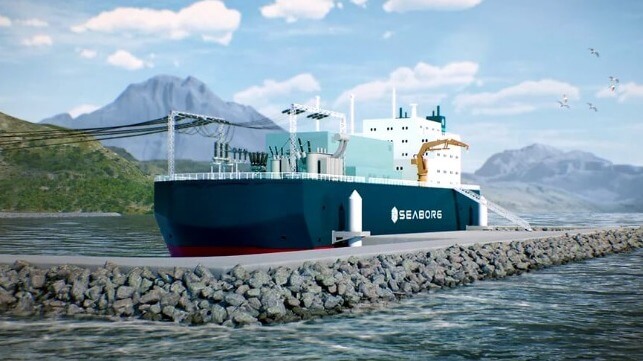Samsung and Seaborg Plan Molten Salt Floating Nuclear Power Barges

South Korea’s Samsung Heavy Industries is forming a partnership with Seaborg, a Danish start-up pursuing next-generation nuclear technologies, and together they plan to develop floating nuclear power plant barges using Compact Molten Salt Reactor technology developed by Seaborg. They believe the CMSR barges can be commercialized as an efficient power source in response to climate change and also can be harnessed to power the green production of hydrogen and ammonia.
The strategic partnership envisions a floating nuclear power plant that comes as a turn-key product, ready to be moored in an industrial harbor. In the harbor, a transmission cable will be connected to the electric grid onshore. Seaborg highlights that the barge will have a 24-year lifetime and be cost-competitive with other power solutions.
Samsung said that it plans to develop an 800 MW model of the floating reactor power plant within the next year by working with Seaborg. They will also conduct classification certification and develop commercial marketing plans.
"CMSR is a carbon-free energy source that can efficiently respond to climate change issues and is a next-generation technology,” said Jintaek Jeong, president of Samsung Heavy Industries. “Through this agreement, we plan to pioneer the CMSR-based floating nuclear power plant market as part of strengthening our future new business opportunities.”
The attraction of the Small Modular Reactor concept is the high-efficiency power combined with the inherent safety of the molten salt-cooled reactor. When an abnormal signal occurs inside the reactor, it is designed to solidify the molten salt to prevent serious accidents at the source. Samsung also said that the smaller size versus other nuclear reactors means that the barge could be used in a variety of fields.
The stable production of energy also offers a fundamental basis for the production of all Power-2-X fuels, where especially hydrogen and ammonia are considered a future energy source to replace traditional fossil fuels, said Seaborg. In the second phase of the partnership, Samsung plans to expand the development and marketing to link the floating power plants with the development of hydrogen and ammonia production facilities.
The concept is to place a hydrogen or ammonia production plant next to the floating nuclear power plant, utilizing the CO2-free fission energy to produce hydrogen and ammonia. The design of the hydrogen, ammonia, and power units will be optimized for efficient serial construction at Samsung’s shipyards.
“We expect that the commercialization of offshore nuclear power plants will be accelerated through technological cooperation with Samsung Heavy Industries,” said Troels Schönfeldt, CEO of Seaborg and co-founder of the company that was started in 2014 in Copenhagen by three physicists. He believes that this new generation of nuclear reactors will be clean and safe and can be built using industrial technology with all the benefits of scalability, speed, and lower costs.
Samsung Heavy Industries separately launched joint research for MSR development with the Korea Atomic Energy Research Institute (KAERI) in June 2021. Among the areas that Samsung is also researching is the use of MSR as a ship propulsion fuel.
